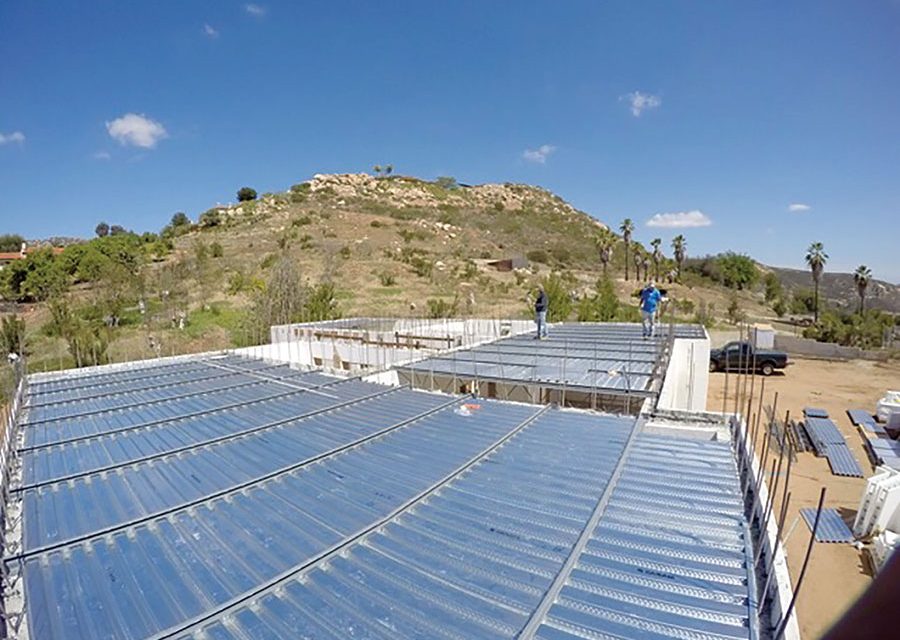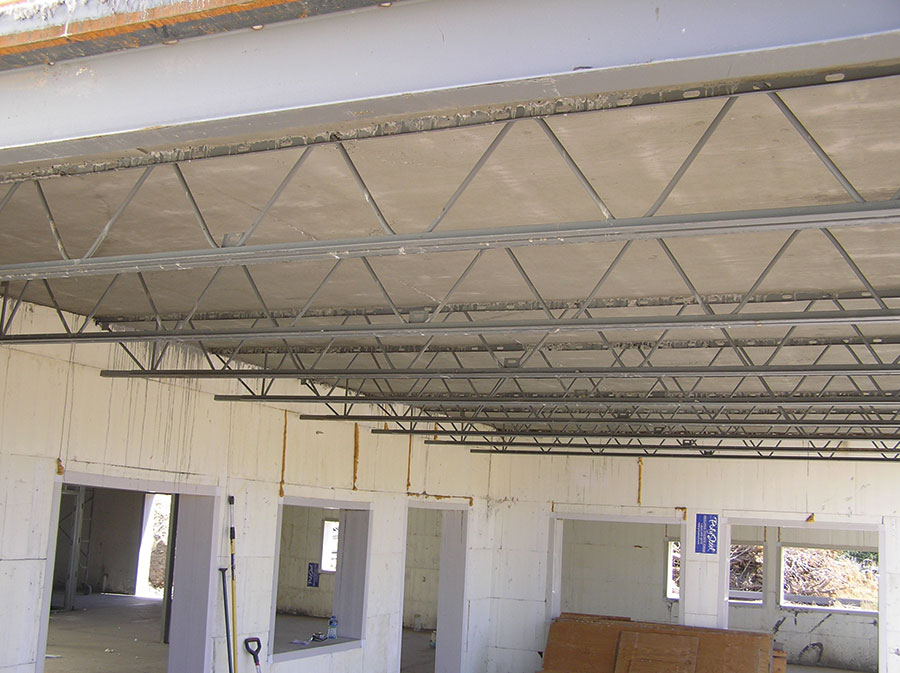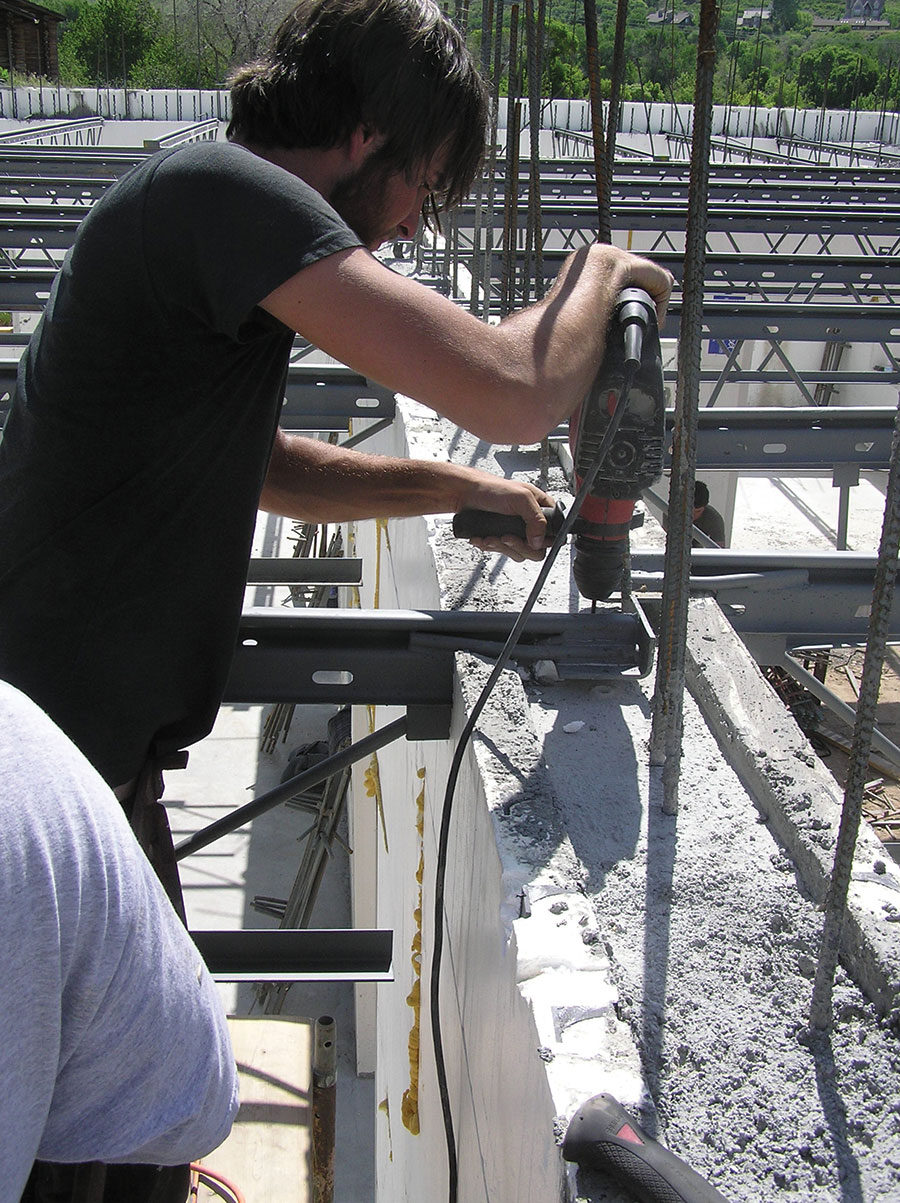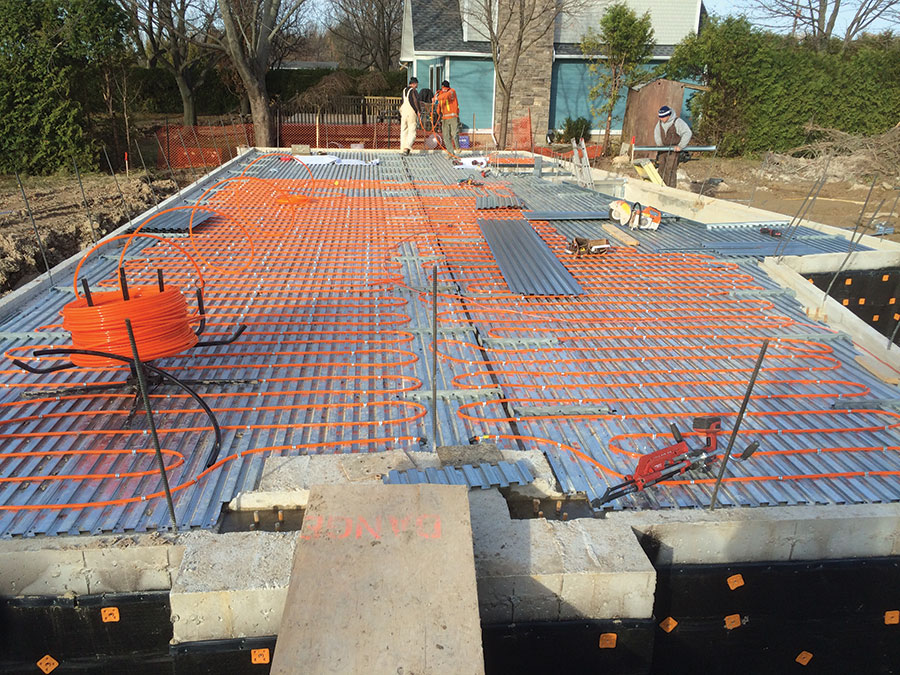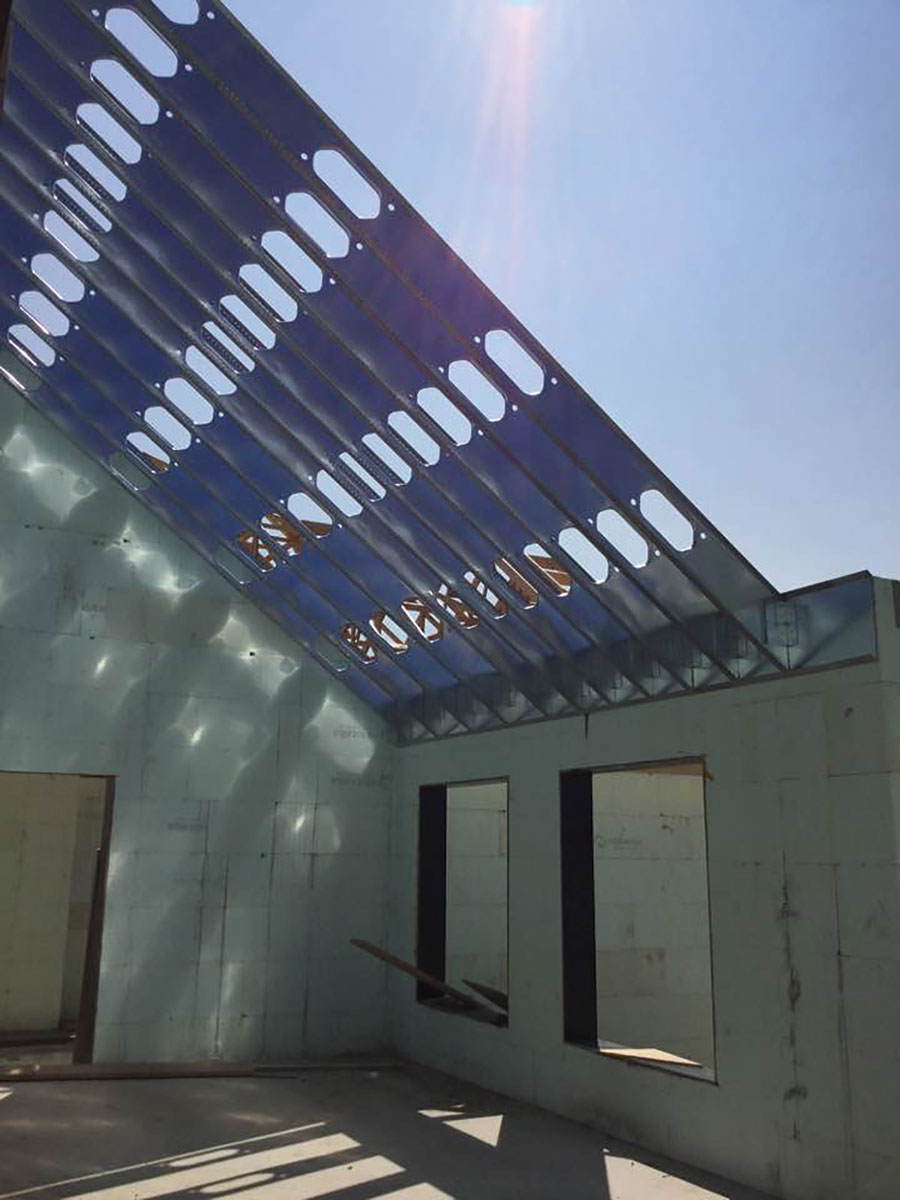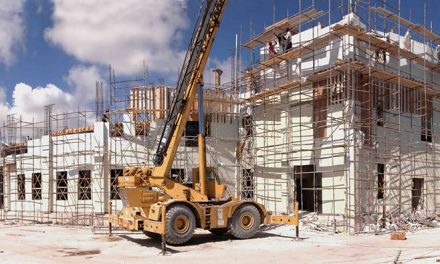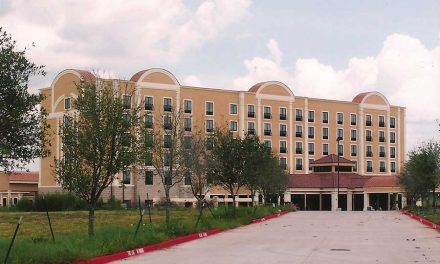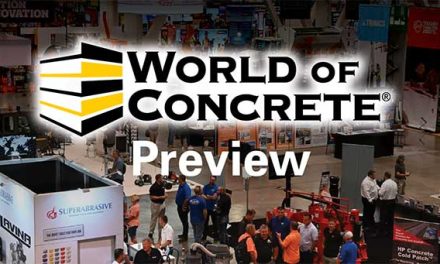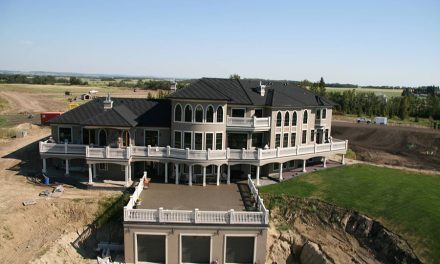Composite steel joist floor systems are a perfect match for ICF construction. This California homeowner selected them for their open spans, fireproof construction, and economical cost.
An increasing number of homeowners, architects, and builders are finding that composite steel joist floor systems are a perfect match for ICF construction. Steel joists topped with a corrugated metal deck and a concrete slab compose a system that is versatile, relatively light, and tremendously strong. In essence, the steel joist takes the tensile load and the concrete absorbs the compressive load, with the floor acting like a flange to prevent twisting.
There are at least half a dozen brands that work well with ICF walls, including EcoSpan by Vulcraft, Hambro by Canam, and Composite Total Joist by iSpan. There’s actually two versions of Hambro; the D500 system uses removable plywood forms between joists, while the MD2000 uses stay-in-place corrugated steel sheets. Metwood, Speedfloor and Dietrich Metal Framing also offer composite joist systems.
The systems are more common on commercial projects, where concrete floors are required due to fire codes. But pourover systems are also used in residential settings, especially if the design calls for long open spans, high-mass floor systems, or in-floor hydronic heat.
Open Spaces
Perhaps the biggest advantage offered by metal decking systems is that they offer longer clear spans with less joist depth. One homeowner explains, “I wanted to obtain open spaces. I didn’t want a column or post every 10 or 12 feet.”
Douglas Fox, PE, the engineering manager at iSpan Systems, states, “Typically, spans of up to 30 feet can be easily and economically achieved, and spans of up to 36 feet are possible.” Competing systems offer similar spans, depending on the depth of the joist. Online tables for Hambro and EcoSpan indicate a joist with a depth of ten inches can span 25 feet, while 18-inch joists can stretch up to 45 feet without intermediate supports.
Joists are typically placed four feet on center, but are
sometimes spaced more widely in residential settings. Mike Callahan, owner of Metwood, says his company’s joists can be placed up to eight feet apart, and still be strong enough to park cars on. As an additional benefit, no additional shoring is usually required while placing
the slab.
Mechanical Systems
Another major advantage of metal joist systems is that they greatly simplify the installation of mechanical systems.
With other floor types, such as precast concrete and EPS decking, all the mechanical work has to be run in a plenum under the floor deck. With steel joists, plumbing, electrical and HVAC can be routed between and through the joists.
Scott Short, Midwest sales manager for Nucor/Vulcraft, says, “Our joists are typically four feet on center, so they can run enormous trunk lines between the joist, with smaller ducts running through the joists, depending on the depth of the web.”
EcoSpan and Hambro use an open web joist. Speedfloor, Metwood, and iSpan use light-gauge steel with pre-formed openings for mechanicals.
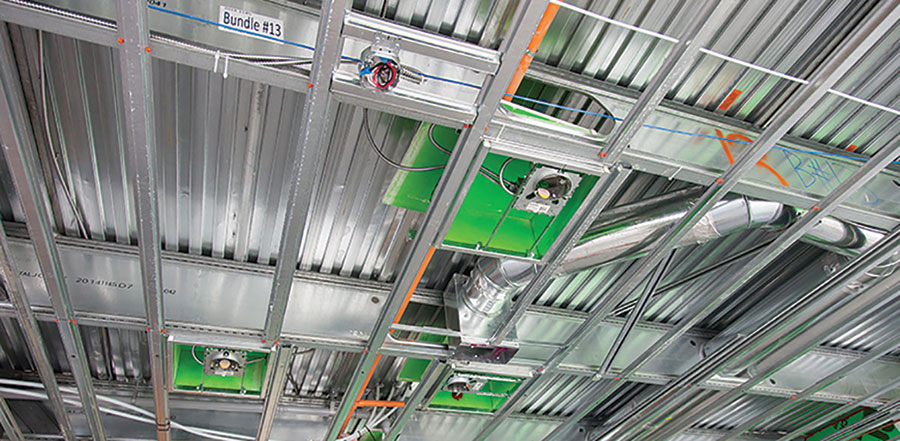
Mechanical, electrical, and plumbing easily fit between and through joists, increasing ceiling heights.
Fox explains, “By default, iSpan’s CTJs come with large web holes at four feet on center that, when installed according to the provided framing plans, line up from joists to joist. This allows for piping, ducts, and electrical to be incorporated into the plenum. CTJs can be customized at no added cost to locate large web holes where needed so that few, if any, additional bends in duct runs need to be introduced.
Simplifying the HVAC and electrical subcontractor work will save both time and money on the overall project cost. Money can also be saved because the total depth of the floor is reduced. Saving one course of ICF and three or four courses of brick on every floor of a mid-rise building can add up quickly.
Dwayne Van Harberden, marketing manager at iSpan Systems says these advantages—long spans and easy mechanical/electrical/plumbing (MEP) installation— makes the product ideal for multi-family residential builds, such as apartments and condos, and is also popular in hospitality buildings, such as hotels.
Short, at EcoSpan, agrees that ICF hotel construction is a particularly compatible fit. “We’ve probably done close to 20 projects of that type already this year,” he reports. He says they’ll typically build weight-bearing corridor walls, and run the joists from the outside ICF wall to the corridor. Then a piece of metal decking only can span the width of the corridor without any joist at all, leaving abundant room for utility trays. He points out that’s only three joists per unit, as opposed to 15 if the joists ran parallel to the corridor. “It goes up faster because there are a lot fewer pieces and parts,” he says.
Ease of Installation
Ease of installation is a major consideration. In commercial construction, time is money, and compressed schedules can save hundreds of thousands of dollars. Composite steel flooring systems can keep pace with the speed of ICF construction.
To further speed up the process, they eliminate the need to get another sub on the jobsite. Typically, any carpenter familiar with light gauge steel studs can install these floor systems. The GC doesn’t need a steel erector. Components can be placed by hand, or if a crane is needed, a lightweight crane is sufficient, rather than the heavy-duty lifts needed to set precast planks. There’s typically no welding, and if shoring is required, it’s usually minimal.
Short, at EcoSpan, says, “Our system can be completely shoreless. If you pour the slab today, you can be working underneath it tomorrow.”
Installation is fairly straightforward: Steel joists are fastened to the concrete core of the ICF wall, then sheet metal decking is screwed into place. Some manufacturers recommend spot-welding the decking into place.
“Framers and/or concrete contractors typically install our product, says Van Harberden, “although they may be pre-assembled on the ground and lifted as modules. The system is pretty easy to learn and no specialization is required. Framers and concrete contractors are familiar with all tools required to install Composite Total Joist. Neither embed plates nor site welding is typically required. Bridging is typically “pinned” to the underside of joist and comes in 16’ lengths.”
Short says, “We’ve have carpenters/framers put it up. We’ve had steel erectors put it up. In a few cases, we’ve had homeowners put it up. A lot of ICF guys like the Ecospan system because it doesn’t require welding. The deck is screwed down. The ends of the joists get bolted directly to the concrete with Tapcons or something similar. The entire system can be weldless.”
The Hambro joist rests on a nut threaded onto a shaft in the concrete. By adjusting the nut, joists can be set exactly level.
The Hambro D500 system uses reuseable plywood forms for the deck. Every other system mentioned in this story uses corrugated steel deck, but there are differences. Short points out that EcoSpan supplies full sheets of decking rather than the shorter sections used by others. While they are more bulky, he says, “We find that it goes up quicker, and makes a better, stiffer platform for the people erecting the building.”
Reinforcing steel and radiant heating—if desired—are set on the deck, and the concrete, typically between two to four inches thick, is placed. Some floors use fiber reinforcement and eliminate the steel mesh.
“Our system is going to be a lot lighter compared to concrete planks, so you can build with thinner walls, and don’t need quite such a big crane on the jobsite,” Short summarizes. “Additionally, you can fit a lot more on the truck, and have shorter lead times from the supplier.”
Other Advantages
Radiant floor systems are a natural fit with concrete floors, as they need thermal mass to assure good heat distribution. Fox, the iSpan engineer, says, “Incorporating the heating system directly into the structural system eliminates the need for a secondary pour or overtopping, making it quicker and keeping total floor thickness to a minimum. Typically, a four-inch slab is recommended.”
Fire ratings up to two hours can be easily achieved using a single layer of 5/8” gypsum board. UL approved firestops are available from a range of manufacturers to seal through-floor penetrations like pipes and cable.
Fiberglass batts may be installed in the floor plenum to improve acoustical separation between units, but that’s usually not necessary. Where most wood floors have a sound transmission rating (STC) of 50, most composite steel joist systems have an STC rating in the mid-50s, and can reach up to 77 with carpeting.
Short points out that it’s easy to get a great finish. Precast planks are cambered and there’s no guarantee two adjoining planks will match exactly. “With bar joists,” he says, “the floor is perfectly smooth on the top and also on the bottom. Just attach the drywall and you have a nice flat ceiling.”
Compared to wood, steel flooring is many times stronger and more rigid. “I can tell when I go into a hotel if the floor is wood, as it has a little bit of a bounce to it,” Short claims.
Van Harberden made a similar statement. “Our system offers large spanning capability, while eliminating floor vibration. Callbacks are minimized because the floors are not susceptible to squeaks and warping like wood framed floors are. Overall, builders get a great feeling floor, quickly installed, at a cost effective price.”
Concrete pourover systems create options that are not possible with any other flooring method. For instance, on sloped lots, builders can create a two-level garage instead of backfilling the foundation. Metwood estimates that using their system, one can build an additional two-car garage under the planned one for well under $20 per square foot.
Contractors in Arizona installed joists at an angle between the inner and outer walls of a church to create a sloped roof. The same technique has been used in a residential setting, including the personal residence of Canada’s largest ICF distributor.
In summary, composite steel decking is a great companion for ICF construction. It is readily available, competitively priced, and installs quickly and easily. In most cases, it requires no shoring, and offers plenty of space for utilities and ductwork.
“It just makes for a much better building,” says Short.

